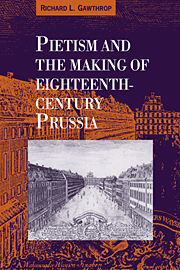Book contents
- Frontmatter
- Contents
- Preface
- Introduction
- 1 The German territorial state in the sixteenth and seventeenth centuries
- 2 Reformed confessionalism and the reign of the Great Elector
- 3 The nature of the pre-1713 Hohenzollern state
- 4 Lutheran confessionalism
- 5 Spenerian Pietism
- 6 From Spener to Francke
- 7 Halle Pietism I: ideology and indoctrination
- 8 Halle Pietism II: growth and crisis
- 9 Pietist–Hohenzollern collaboration
- 10 The impact of Pietist pedagogy on the Prussian army and bureaucracy
- 11 Civilian mobilization and economic development during the reign of Frederick William I
- Conclusion
- Bibliography
- Index
9 - Pietist–Hohenzollern collaboration
Published online by Cambridge University Press: 14 October 2009
- Frontmatter
- Contents
- Preface
- Introduction
- 1 The German territorial state in the sixteenth and seventeenth centuries
- 2 Reformed confessionalism and the reign of the Great Elector
- 3 The nature of the pre-1713 Hohenzollern state
- 4 Lutheran confessionalism
- 5 Spenerian Pietism
- 6 From Spener to Francke
- 7 Halle Pietism I: ideology and indoctrination
- 8 Halle Pietism II: growth and crisis
- 9 Pietist–Hohenzollern collaboration
- 10 The impact of Pietist pedagogy on the Prussian army and bureaucracy
- 11 Civilian mobilization and economic development during the reign of Frederick William I
- Conclusion
- Bibliography
- Index
Summary
THE PIETY OF CROWN PRINCE FREDERICK WILLIAM
The impressive growth of the Halle Anstalten after 1700 and the sense of solidarity and self-consciousness that developed among the Pietist cadres initiated a new phase in relations between Halle Pietism and the Hohenzollem state. Thanks to its economic strength and worldwide missionary connections, Francke's movement was no longer so dependent on the Brandenburg-Prussian government. Partly because of this increase in the power of Halle Pietism and partly because of circumstantial political factors in Berlin, the nature of the relationship between the Pietists and the state underwent a series of changes between 1700 and 1713. During this period of transition, all the possibilities inherent in the situation were realized. The Pietists contemplated using the state for their own purposes; the Berlin regime took steps to cut the Pietists “down to size,” and the impending ascension to the throne of an intensely religious prince offered the prospect of close collaboration between the two parties. Since this interaction between Pietists and Hohenzollerns took place at a time of acute political instability in Berlin, the final outcome was by no means predetermined. Ultimately, however, the decisive factor was the precise character of the religious convictions of the heir apparent, who in 1713 ascended the throne as Frederick William I.
As we have seen, Francke's strategy for achieving “world reform” developed in the years immediately following 1700.
- Type
- Chapter
- Information
- Pietism and the Making of Eighteenth-Century Prussia , pp. 200 - 222Publisher: Cambridge University PressPrint publication year: 1993



